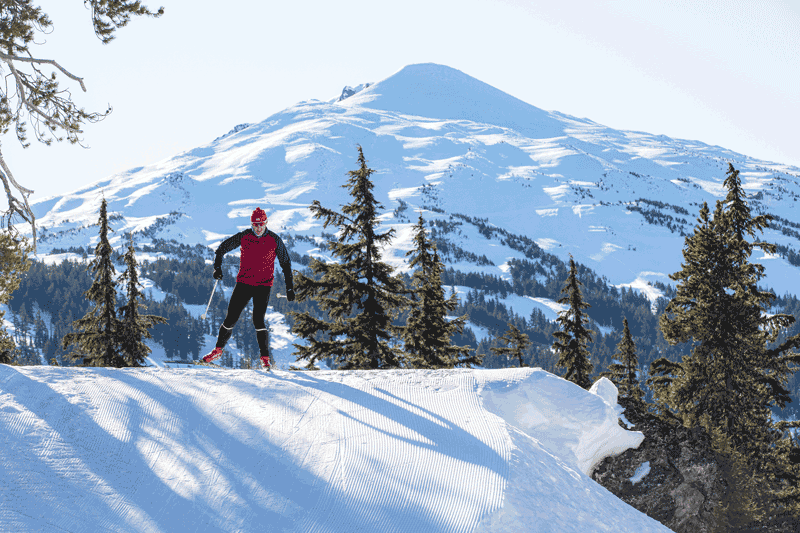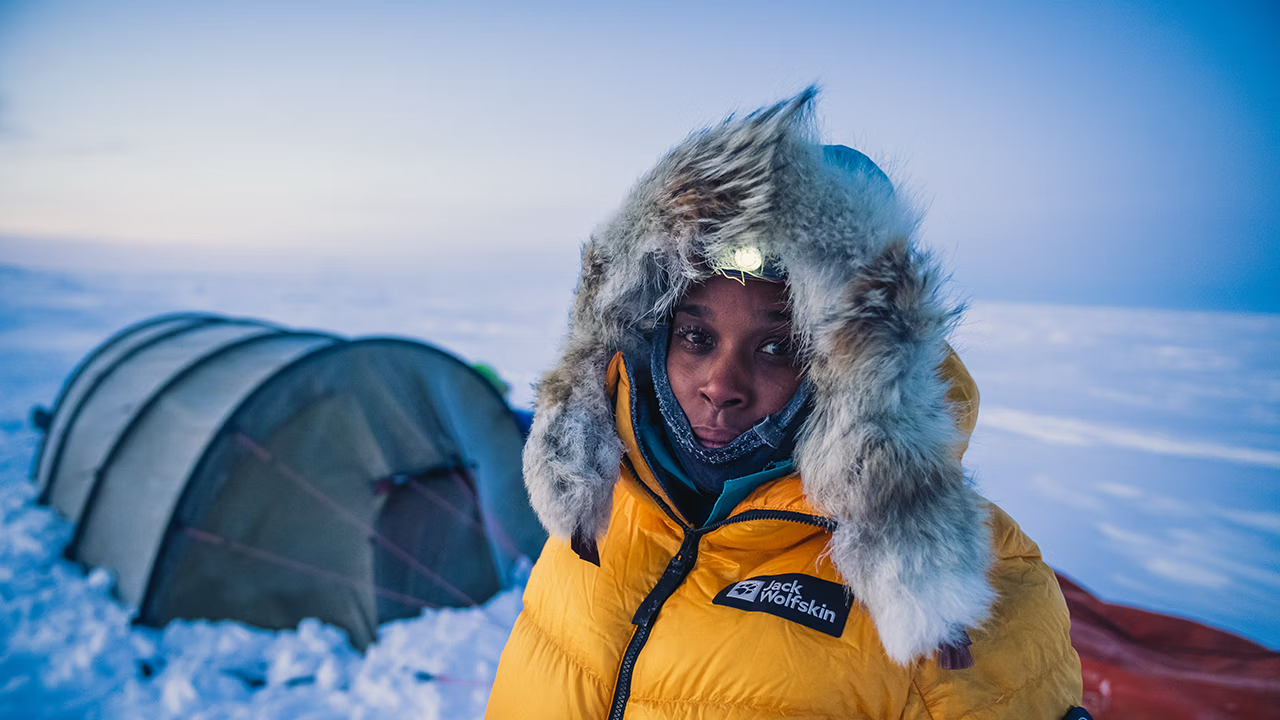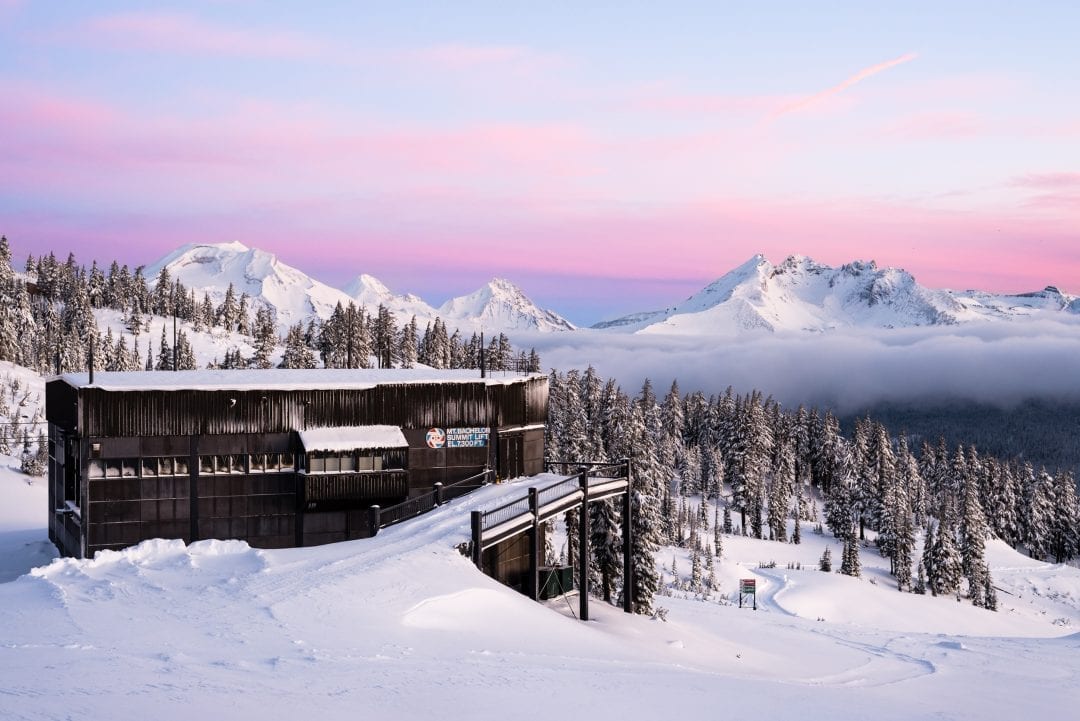The Meissner Nordic Ski Club was at it again, and the Forest Service roads and paths southwest of Bend were once again magically transformed into glorious ribbons of cold, corduroy snow. It’d been a tough day at work, but now, standing in the parking lot at Virginia Meissner Sno-Park, the stress faded like so much daylight. A light snow fell. I stepped into my skis and cast off into the purple night, the flakes strafing through the cone of my headlamp.
We live within eyeshot of one of the nation’s largest downhill ski resorts, but we’re also a Nordic skiing paradise. Between Mt. Bachelor and Virginia Meissner alone, the area has more than 100 kilometers of groomed cross country trails, nearly half of which are free thanks to the Meissner Nordic Ski Club. Countless other trails wind around snowy buttes, back to cozy cabins and along quiet lakes. For little to no money, cross country skiers can glide through a winter wonderland where the forests sigh under the weight of the flakes and the tranquility can be exquisite. Or, if you’re one of the countless Nordic athletes in town, you can push yourself so hard the world blurs at the edges, and you feel as if you might cough up a lung.
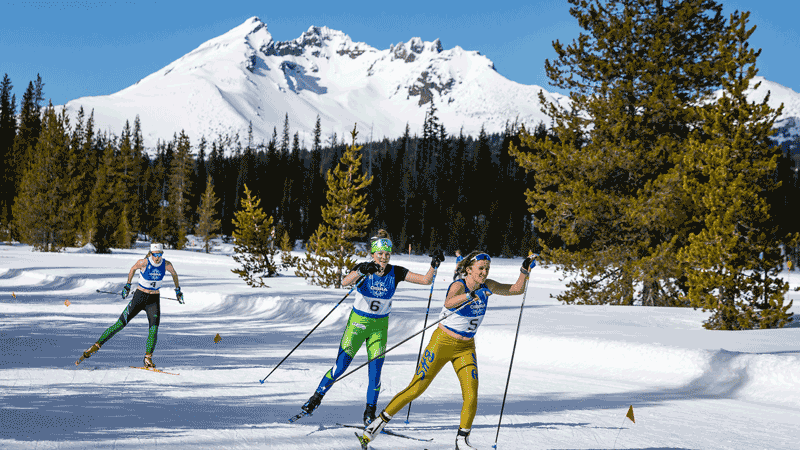
Nordic Definitions and Dedication
The range of experiences, athleticism and dedication the sport inspires is a big reason why Nordic isn’t just downhill skiing’s kid brother but a passion that many in Central Oregon embrace with near fanaticism. You can “classic” ski (in which your skis remain parallel, often in a set track) or “skate” ski (in which your skis act more like ice skates on a wide, groomed track). “If you can jog you can basically ski classic,” said Mark Jobson, an instructor at Mt. Bachelor’s Nordic Center. “[But] skating is a lateral motion that is quite foreign to most of us.”
In Bend’s annual Pole Pedal Paddle multi-sport race, the Nordic leg often determines a winner from a runner-up. The winners all skate ski because it’s faster—and more taxing—with a lot of coordination and balance needed to sync the various poling techniques, called V1, V2 and V2 alternate, with your legs. A skier’s entire weight must also transition repeatedly from one ski to the other, all while everything is moving. “Historically I think it’s rare for people to do well in the race unless they have a history of Nordic skiing,” said Jesse Thomas, winner of last year’s event, who trained diligently on cross country skis to make up for his lack of Nordic history. Multiple Pole Pedal Paddle winner Marshall Greene, a one-time World Cup racer, beat Thomas by a whopping three minutes on the Nordic leg that takes elite racers just fifteen minutes to complete. Taking advantage of an extended training season, Olympians such as Dan Simoneau, Justin Wadsworth and Beckie Scott have all called Bend home at one time. Members of the U.S. Ski Team are frequently spotted on the trails well into late spring.
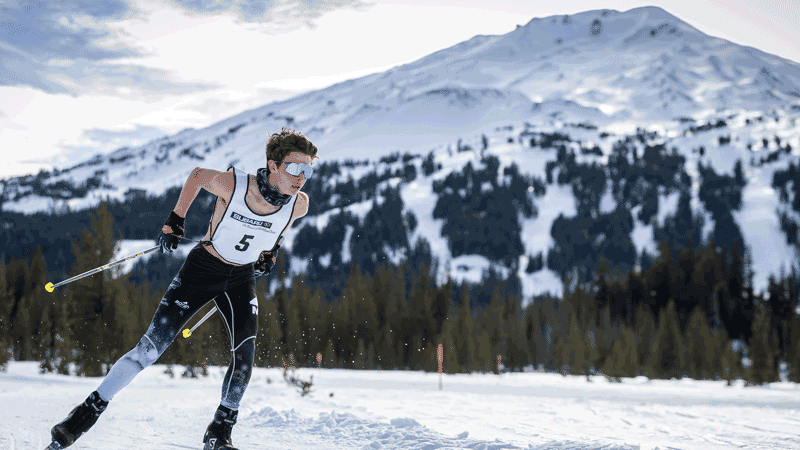
Training Grounds
Central Oregon produces youth standouts as well. Across the entirety of Oregon, about 250 students will be racing both classic and skate for their high schools, and more than half of them will come from Bend. A major reason the state has a high school racing program is largely thanks to Bend resident Jinny Martin, who spearheaded the statewide effort in the late ‘90s. “It’s pretty cool how amped the high schoolers here get,” said Martin’s son, Eric Martin, a National Masters Champion who graduated from Mountain View High School in 1984 and has been the school’s cross country ski team coach for twenty-three years.
If you had to pick one student racer to watch this season, follow Bend High’s Neve Gerard. The athlete, who started skiing in sixth grade, had barely turned 16 last March, when she earned two podium finishes at her first U.S. Junior Nationals Cross-Country Skiing Championships in Minneapolis. “It’s pretty cool, to have gone to Nationals and podiumed there,” Gerard said. But the truly remarkable thing is how she’s hardly alone. “We have a very large number of kids who will qualify for junior nationals, and a few of them have the potential to be on the podium,” said Dylan Watts, the Nordic director for the Mt. Bachelor Sports Education Foundation.
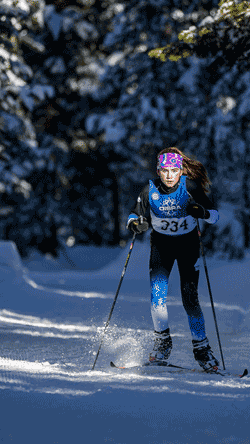
Getting Started
While skiing at Virginia Meissner Sno-Park is free thanks to its volunteers and a Nordic day pass at Mt. Bachelor costs just $30 (versus $155 or more for a day of alpine skiing), cross country skiing can still be an expensive sport to start, with the hard goods alone costing more than what many families can afford. But Martin said he’s able to outfit each member of the Mountain View team with two pairs of skis, two pairs of poles and a pair of boots each for as little as $20 a year thanks to donations from the community. Unlike a lot of other competitive high school and club sports, no one gets cut from the team.
Often, getting started with Nordic skiing begins with a simple question. “Do you want to ski on snow that has been prepared by a groomer or snow that is virgin and isn’t prepared?” said Jobson. “That’s going to lead you to decide what type of equipment you put on your feet.” From there, beginners can rent skis at a local shop such as Sunnyside Sports, Pine Mountain Sports, or Powder House Ski & Snowboard, and head out with friends or up to Mt. Bachelor to take a lesson. Later, skiers might want to consider signing up for an XC Oregon camp. “A lot of our people are looking to improve upon very specific technical things that they’re struggling with,” said XC Oregon founder John “J.D.” Downing. Maybe they aren’t transferring their weight as well as they could or perhaps their poling technique is off. Our camps really smooth out those edges.”
As for me, that night at Meissner still ranks as one of my favorite evenings of the more than 6,500 I’ve had in Bend. Everything seemed to click. I skated along the flats and up the climbs, threading that line between exertion and exhaustion. Halfway through, I stopped and turned off my headlamp to marvel at this amazing gift we call a Central Oregon winter. Jobson can relate. “Folks ask me, ‘Why are you so dedicated to this [sport]?’” he said. “I say, because winter is the most magical time to be outside.”
Moonlight Trails
As ski lifts are put to sleep for the night and when the sun sets, the time is ripe for Nordic skiers to begin what is often considered one of the most magical experiences on skis: gliding by the light of the rising moon.
When the phases of the moon approach maximum fullness, snowy trails are illuminated by reflections provided from light as it bounces between sky, snow and any clouds to offer a bright glow complete with moon shadows. Experienced skiers that traverse Bend’s trail systems during the daylight hours may feel confident skiing solo in the nighttime silence with the only sound being the swish of snow crushed under a sliding ski. Yet, a classic adventure is a group ski to a snow shelter with friends with the reward of a respite under the stars before a return to the trailhead.
Night Ski Tips:
- Check a Farmer’s Almanac to find dates when the moon approaches full. The next dates in Central Oregon are January 6 and February 5.
- Watch weather to assess not only safety in the skies, but the snow conditions. See meissnernordic.org/weather/ for webcams and readings.
- Know the trails. Bring a map and a headlamp. While moonlight brightens the terrain, landmarks may appear different under a general cloak of darkness.
- Bring extra clothing, water and food. Temperatures after dark drop quickly.
The Luminaria event, a long-time tradition hosted at Virginia Meissner Sno-Park by the volunteer-supported nonprofit Meissner Nordic Ski Club, will not be held this year, a product of too much love. “The Luminaria was great while it existed,” said Steve Roti, board president of Meissner Nordic Ski Club. “It started small and grew with the ski community until the size of the event outgrew the size of Virginia Meissner [Sno-Park}.” This year, start a new tradition with family and friends. Watch for music concerts and hot chocolate nights under the moonlight at Meissner.
See meissnernordic.org.

